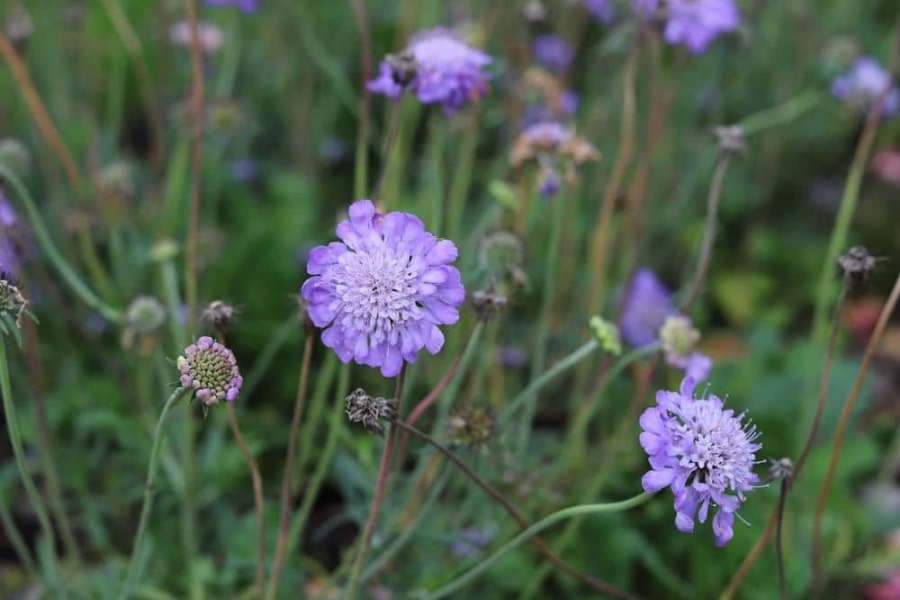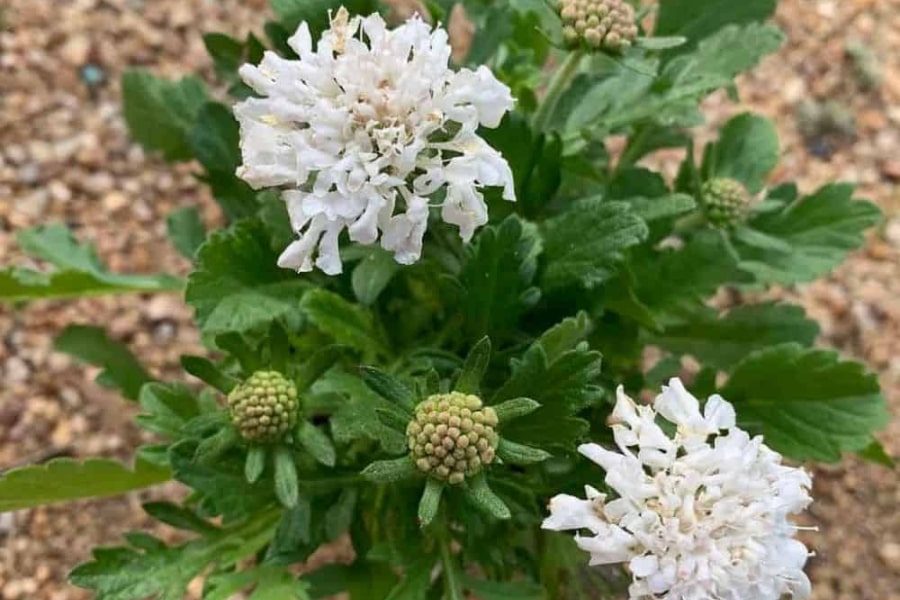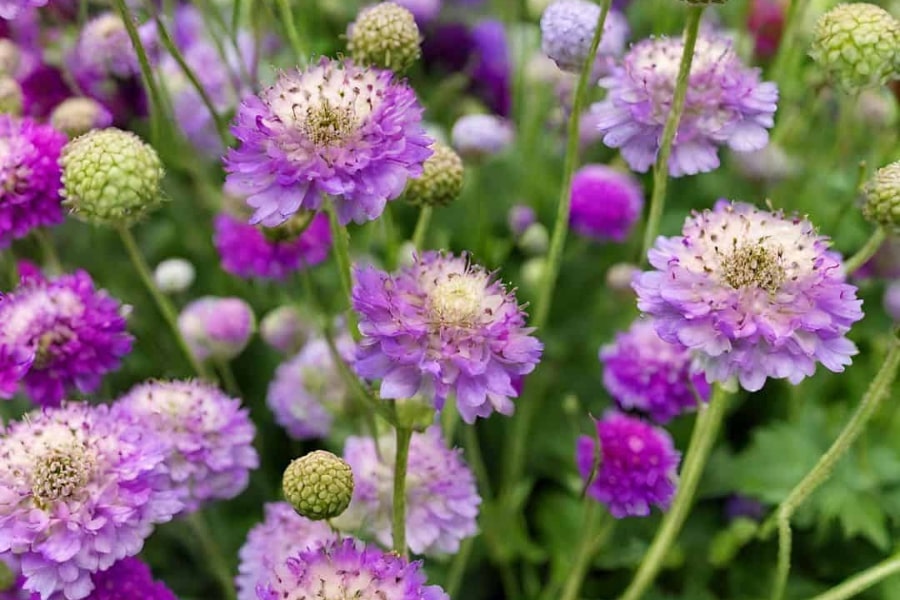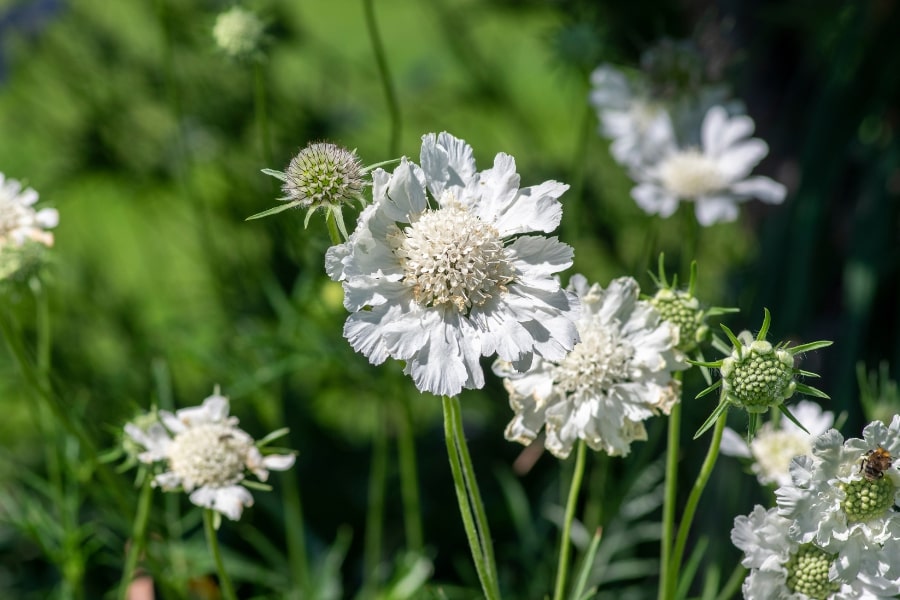Scabiosa, commonly known as Pincushion Flower, is a delightful perennial plant that belongs to the Caprifoliaceae family. These plants are native to Europe, Africa, and Asia. Scabiosa has a remarkably long flowering season, often lasting from early summer well into fall. The name “Pincushion Flower” stems from the distinctive shape of its blossoms, which resemble a cushion filled with pins.

Our Selection of Scabiosa
At Martin Garden Center, we both grow and bring in Scabiosa varieties in 4″ containers. We also carry various seed for other varieties not commonly grown by vendors in our area. Many of these are considered annuals but will self-seed. We try to stock 4″ Scabiosa from Spring through Fall, as it will bloom non-stop if deadheaded and trimmed back regularly.
We are growing the following varieties in 2025:
- Butterfly Blue
- Pink Mist
- Pure White
- Vivid Violet
Growing and Caring For Scabiosa
Begin by selecting a location with well-drained soil and full to partial sunlight. These plants generally prefer soil that is not overly rich and has good drainage to prevent waterlogged conditions, which can lead to root rot. Plant Scabiosa in the spring or fall, ensuring the soil is workable. Dig a hole slightly larger than the plant’s root ball and place it at the same depth it was in the container. Space multiple Scabiosa plants about 12 to 18 inches apart to allow for proper air circulation.
Scabiosa plants have moderate water requirements. Water regularly, especially during dry spells, to moisten the soil. However, be cautious not to overwater, as Scabiosa is susceptible to root diseases in waterlogged conditions. Mulching around the base of the plant helps retain moisture and regulates soil temperature.
Deadhead spent flowers regularly to encourage continuous blooming. This prolongs the flowering period and maintains the plant’s neat appearance. Light pruning in late spring or early summer can help control the plant’s height and shape, promoting a bushier growth habit and preventing it from becoming leggy. A balanced, all-purpose fertilizer applied in early spring can provide the nutrients for healthy growth and abundant blooms.
Scabiosa is generally resistant to many pests and diseases, but occasional issues may arise. Look for aphids or spider mites, especially during dry periods. Insecticidal soap or neem oil can help control these pests. Good air circulation and proper spacing can prevent fungal diseases. Regularly inspect the plants for any signs of problems and take prompt action to maintain the overall health of your Scabiosa.

Leaves and Flowers
The leaves of Scabiosa are typically basal, forming a rosette at the base of the plant. They are deeply lobed and often have an attractive, fern-like appearance. The leaves vary in color, ranging from rich green to gray-green, depending on the species and cultivar. Their distinctive texture and form create an appealing contrast against other plants in the garden.
The flowers of Scabiosa are a true highlight, capturing attention with their unique appearance and vibrant colors. The blooms are composed of a central, raised cone surrounded by a fringed disk of petals. The disc is usually dark, ranging from deep purple to black, strikingly contrasting the petals. This distinctive “pincushion” structure gives rise to the plant’s common name. Scabiosa flowers come in various colors, including shades of blue, pink, lavender, white, and even deep burgundy.

Scabiosa, commonly known as pincushion flower, is a charming and versatile addition to any garden, valued for its long-lasting blooms and ability to attract pollinators. Its delicate, button-like flowers add softness to perennial borders, cottage gardens, and wildflower meadows, blending beautifully with other nectar-rich plants like Lavender, Salvia, and Echinacea. Scabiosa’s compact growth habit also makes it an excellent choice for edging pathways or filling gaps between taller perennials, adding continuous color from Spring through Fall.
Scabiosa is also highly beneficial for pollinators, drawing in butterflies, bees, and other beneficial insects. It also works well in cut flower gardens, as its blooms last a long time in vases, adding a delicate, airy touch to floral arrangements. Pairing Scabiosa with ornamental grasses or silver-foliaged plants like Artemisia creates a striking contrast that enhances its soft, billowy flowers.

Frequently Asked Questions
Is Scabiosa Deer Resistant?
Deer tend to avoid plants with aromatic foliage, and the fragrance of Scabiosa act as a natural deterrent, reducing the likelihood of deer browsing on these plants.
Is Scabiosa A Perennial?
Yes, Scabiosa is a perennial that returns year after year, if provided with the proper growing conditions and care.
How Tall Does Scabiosa Grow?
The height of Scabiosa can vary depending on the specific species and cultivar, as well as growing conditions. Dwarf or compact Scabiosa cultivars may stay around 12 to 18 inches tall and are suitable for the front of borders or in containers. Many standard Scabiosa cultivars fall 18 to 24 inches in height, while some taller Scabiosa cultivars can reach heights of 24 to 36 inches (60 to 90 cm) or even more.
